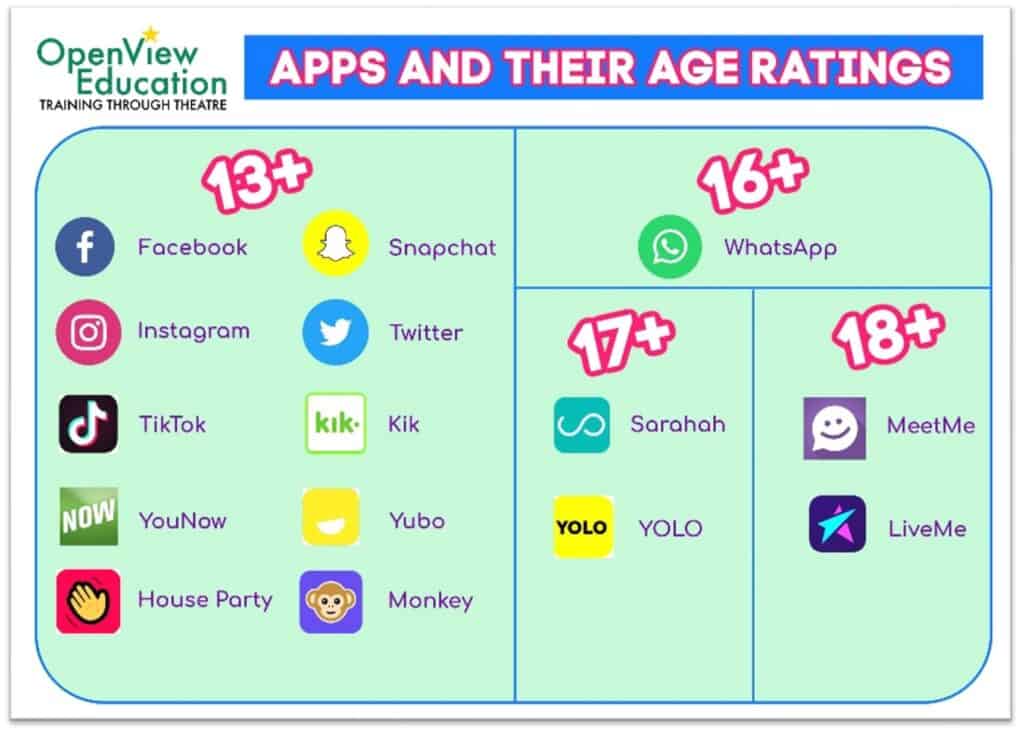Dear Parents and Carers
Social Media
In my second post-Ofsted letter, I shall turn our attention to the use and impact of social media at Chipping Norton School.
Much like driving, scuba-diving, fast food or watching TV, social media is not something to be condemned, even though it carries a few risks.
Age Ratings
The table below provides a helpful summary of the various age ratings and perhaps the first thing to do is reflect on your child’s age and their current use of social media.

We know that when we point out some of these age ratings to parents and carers, there can be some surprise. How can something as amusing as TikTok be meant for older children, and why is WhatsApp only supposed to be restricted to students in our oldest year groups?
And yet we know that WhatsApp can be used to create cliques, or ostracise and exile other children. TikTok exposes us all to daft crazes, but can also expose us to unsettling content and warp our sense of ‘norms’. Snapchat and Instagram can ‘catch us at our worst’ as we gossip; or mock, slate and insult those around us with little immediate thought of the consequences.
Several things strike us as staff when we work with children and their families to recover from the negative effects of social media – whether that is when they are on the receiving end, or when they have deliberately or inadvertently hurt others:
- There is no pattern when it comes to whether boys or girls use social media negatively;
- Children with no history or pattern of misbehaviour or unkindness ‘in the real world’ are as likely to misuse / make mistakes as others.
There is something odd at play when it comes to who we are and how we behave on social media. It can reduce our inhibitions; making us more confident and funnier, or more critical and mocking – empathy levels seem to dial down a notch or two in cyberspace.
The misuse of social media (and by that, I mean posting hurtful comments, videos or memes) is often, if not typically, between current or former friends. Whilst this still constitutes bullying, it is distinctly different from the old fashioned ‘Gripper Stebson / Imelda Davis’ bully stereotype from the TV series Grange Hill, that mercilessly stomps the playgrounds and corridors. Harm caused by a former friend can make the repair and rebuild conversations more complicated and we occasionally see students forgive, forget and move on before we have barely finished resolving the issues with families. There can be a fast-moving fluidity to friendships and a blisteringly rapid turnaround from when children are close and ‘tight’, to when they fall-out over a comment, misjudgement or misunderstanding.
The misuse of social media often takes place late at night or in the early hours. It is clear that messages are received when children are alone and then face anxious and miserable nights dealing with the figurative and literal fall out, wondering who has seen, who is involved, what will people say tomorrow, and will there be a ‘pile-on’.
A major spat or attack on social media can lead to the prolonged absence of a number of students involved – both the messenger and the victim. This appears to reflect the shame and embarrassment often felt by the person who has misused social media, or reflect the social anxieties experienced by the victim.
And yet, we are talking about children who are exploring life, relationships and communication. Children have always squabbled and disagreed, and probably always will, but the tools provided by social media can make those squabbles, teasing, mockery or fallouts seem and be more ‘catastrophic’ for the victim, and reverberate for much longer. And so, what can we do about this?
Let’s start with what we cannot do or will not do…
- We shan’t be banning mobile phones at CNS. Our current policy of ‘out of sight during school hours’ is reasonable and sensible. It can be monitored and we can take steps to remove those phones temporarily or permanently when seen or misused.
- We shan’t be permanently excluding every child who uses social media to upset others. This is an understandable request or demand from distressed parents and carers when their child has been hurt or harmed. Instead, we act proportionately, but this often means we involve PC Chris Jones, our community liaison officer, with a visit to the child and their family if they need to be reminded of the law in this regard. Persistent misusers of social media are managed very differently of course.
And what do we do already?
- We do deliver lessons in tutor time and in character education to educate students about the educational and legal aspects around the misuse of social media. This has more effect on some than others but does at least mean no child acts in ignorance of the law, or is unaware of what is kind and acceptable.
- Naturally, we issue appropriate sanctions if behaviour outside school has an impact on students in school.
- We prioritise ‘repair and rebuild’ conversations on those occasions when the upset has taken place between friends and all hope is not lost for a speedy restoration of friendship and understanding.
- When a child misuses social media we engage the parents or carers to ensure they also take positive steps to help protect their own child (and others’ children) from further misuse of technology and apps. This may take the form of better or more assertive monitoring of their social media activity (see advice below), or simply to collect their phone and other devices at an agreed time each day. Many parents and carers are unaware that an Xbox or PlayStation, for instance, provides very easy access to social media apps as well.
- We try to gently challenge parents and carers. Not just the parents or carers of the child who has caused harm, but also, in some cases, the parents and carers of the victim. Too often we see a pattern of premature access to social media apps and an abundance of late-night / unsupervised activity. Whilst no victim can be blamed, there are some important questions to be asked about how and when all children are accessing social media and the extent to which we are, as parents and carers, wilfully unaware of the risks to our children’s wellbeing and safety.
What else do we need to do?
- We must certainly maintain our education around social media; both in terms of the law and the way to use it safely and kindly. This also includes being aware when it is time to step back from certain conversations, or report concerns to the right adults.
- Promote digital detox days or weekends to draw attention to an obsessiveness or dependency that can creep into all our use of technology.
- Support and challenge parents to come up with their own action plan to protect their own child from harm and other children.
- We also have to take a long look at ourselves. What do our own children see us doing each evening? Are we on our phones and tablets, flicking through social media apps, and not being ‘present’? It is next to impossible for us to expect our children to dispense with their tech if we cannot model the same habits, and show how to live in the moment and take pleasure and delight in the company of our family.
And breathe…
Being willing and able to be ‘still’, ‘present’, ‘mindful’, ‘in the moment’, or ‘one step removed’ from the hurly burly of social media traffic may well turn out to be the wisest decision a young person will make in their teenage years. Politicians and celebrities have spin doctors and media advisers to help navigate the nuance of every hasty or ill-considered comment, or they can rush to their aid when something they have posted, liked, or retweeted has caused everything from a pile-on to ridicule. And yet our children have to manage all of that on their own, often late at night, when the home is quiet and when there is no one to turn to and say… ‘help’.
Working in partnership with families…
The NSPCC website is a wonderful source of information. The NSPCC identify six key risks: oversharing personal or sensitive information in order to build rapport or cement trust; sharing locations; talking to people they don’t know or whose identify is fraudulent; sending or receiving inappropriate content; becoming habituated to unrealistic expectations around body image, wealth and ‘success’; and an obsessive focus on one’s likes and comments – as a means to calculate one’s approval in the world.
The Young Minds website is a great resource for us all and helps slightly nervous parents and carers take positive and assertive steps to protect their children. Tips include how to talk to your child about social media, how to set realistic boundaries, asking the right questions about gaming, helping them to spot and respond correctly when cyberbullying occurs – as well as advice on the warning signs that things are going wrong or have gone wrong – and where to get more support.
Limiting Screen Time and Accessibility
The Independent produced a great article to help parents and carers restrict and reduce their children’s screen time. The article includes helpful tips and links to special apps that are becoming much more popular and routinely used in homes across the world. These include: Google Family Link, FamilyTime, Qustodio, ESET Parental Control and WebWatcher.
Yours faithfully
Barry Doherty
Headteacher


